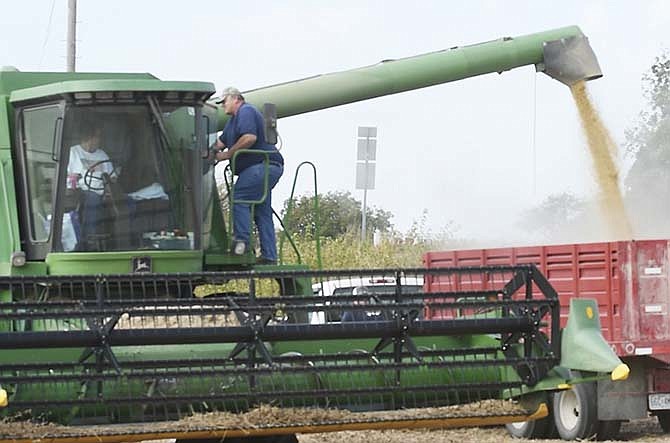Some Mid-Missouri farmers are harvesting smaller-than-usual soybean yields after heavy rain early in the growing season pushed back planting.
"They're all over the board, depending on how affected they were by the flood. There's very low yields; and there's, of course, people who have some high ground that wasn't affected," said Drew Parmley, executive director of the USDA's Cole/Miller County Farm Service Agency. "They weren't anything close to a bumper crop, but they weren't horribly bad."
While Parmley's office does not collect yield numbers for the two counties, he stays in regular contact with local farmers for crop reports throughout the season.
Parmley estimated area farmers' soybean yields this year range between zero and 35 bushels per acre, with 35 bushels per acre being an average yield for a typical year. "I would say the bulk of that was on the low end of that scale," he added.
Soybean planting lagged behind schedule this year when Missouri experienced its wettest June since the National Weather Service began keeping records in the late 1800s. Farmers were unable to plant not only on days when it rained, but also for days afterward as they waited for the ground to dry sufficiently.
"The type of ground that we have needs several days to dry out, and by the time it dried out, it was past the middle of July," said Harry Thompson, who this year planted only about two-thirds of the soybeans he had planned to on his farm near the Moreau River in Cole County. "We were fortunate to have crop insurance, so it made more sense to take a prevented-planting payment than to put a crop in the ground."
The coin flipped in late summer and early fall, when extremely dry weather kept some soybean plants that made it into the ground late from getting enough water.
"Farmers who planted soybeans in July understood their crop was at risk," Bill Wiebold, University of Missouri Extension agronomist, said in a news release. "But the degree of drought in August and September was highly unusual and impossible to predict."
For good yields, soybean plants need about 1.2 inches of rain weekly during the grain fill period, according to MU Extension information. Cole County accumulated between 1-1.5 inches of precipitation in all of September, according to the Missouri Department of National Resources.
"It probably took a few bushels off our bean yield by not having that late August or early September rain," Thompson said. "It could have made a big difference. We could have had a good yield if we'd had a decent rain or two."
The U.S. Drought Monitor still lists most of Mid-Missouri in moderate drought - the lowest drought level on a four-level scale - as of Oct. 27, the most recent date's data available.
The recent dry weather has made for a quick harvest, said Thompson, who finished harvesting soybeans more than a week ago.
Missouri's statewide soybean harvest is at 67 percent as of the week ending Oct. 25, the most recent week's data available. That's far ahead of last year's 43 percent at the same time, and slightly outpacing the 2010-14 average of 60 percent by that date.
The same is true for corn. Missouri's corn crop was 94 percent harvested as of the week ending Oct. 25, compared to 67 percent at the same time last year and 84 percent on average between 2010-14.
Parmley estimated farmers in Cole and Miller counties harvested between 50-120 bushels of corn per acre, estimating an average year would produce about 145 bushels per acre. While most corn made it into the ground on time before the wet weather, the heavy rain damaged some of the crops.
Thompson's yields, while smaller than last year's, don't concern him.
"The crops that we got in the ground that we planted where we managed to get a day of sunshine before they got another rain actually ended up doing fairly well - not the best year we've ever had, but respectable," he said. "And our corn crop did good."
The wet spring and late planting has put his hay harvest about a month behind schedule.
Prices are hard to predict, but the decreased local supply doesn't necessarily translate to higher demand.
"Prices are so much driven on an international basis, and you've got this gigantic corn belt in the middle of the United States that may not have been as adversely impacted as we were. Their production is greater than ours typically," Parmley said.
"Our reduced production and low prices is kind of a double-whammy."

